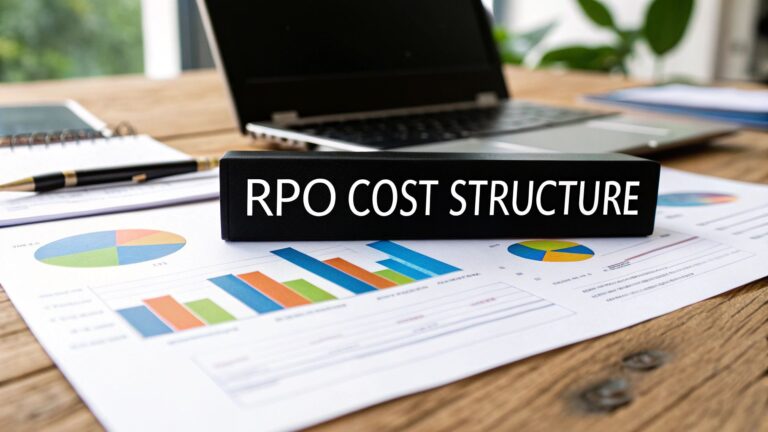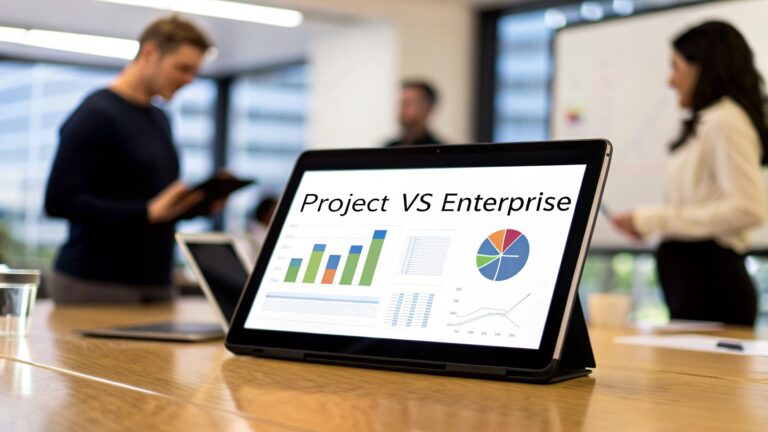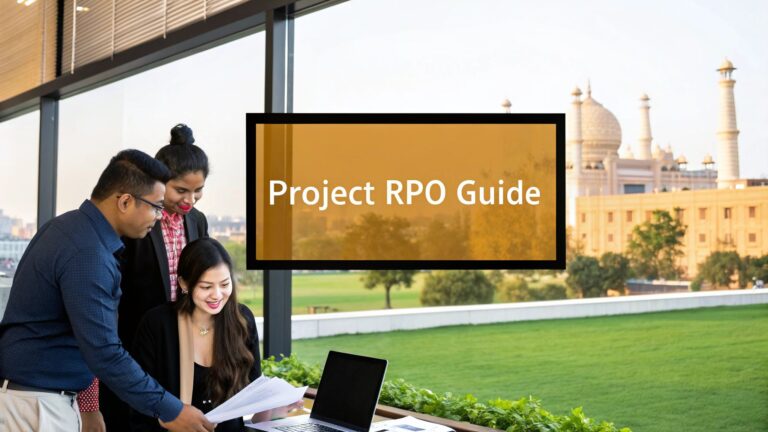In today’s fast-paced corporate world, the HRBP plays a crucial role in aligning people strategy with business success. But what exactly does HRBP stand for? The full form of HRBP is “Human Resources Business Partner.” An HRBP is a strategic HR professional who works closely with leadership to drive workforce effectiveness.
Unlike traditional HR roles focused on administrative tasks, an HRBP meaning in HR revolves around being a trusted advisor, ensuring that HR initiatives directly support business growth.
So, what are the key HRBP roles and responsibilities? In simple terms, an HRBP bridges the gap between employees and management, focuses on talent development, organizational culture, and performance management while ensuring HR policies align with company goals.
In this blog, we’ll break down:
- What an HRBP does- core duties, roles, and responsibilities
- How HRBPs drive business success- their strategic impact in linking HR strategy with leadership objectives.
- A day in the life of an HRBP- discuss real-world tasks that keep them at the heart of decision-making.
- Skills and Job Description of an HRBP
By the end, you’ll have a clear understanding of why HRBPs are indispensable to modern organizations and how they contribute to long-term growth. Let’s get started!
Who is an HRBP?
In simple terms, An HRBP (Human Resources Business Partner) is a strategic HR professional who works closely with business leaders- not just to manage HR tasks, but to drive company success through people.
An HR Business Partner is the link between employees and management. While traditional HR focuses on policies, payroll, and compliance, an HRBP goes beyond. HRBP roles include helping leaders make smart decisions about hiring, employee growth, team performance, and workplace culture to meet business goals.
They understand the company’s objectives, industry trends, and workforce dynamics. They partner with departments like sales, marketing, or operations to address challenges like talent retention, employee engagement, and leadership development. In essence, an HRBP is the glue that connects people strategies to business outcomes.
HRBP Meaning in HR:
HR = Human Resources (managing people in a company)
Business Partner = A collaborator who aligns HR strategy with business needs
In short, HRBPs act as consultants, advisors, and change agents, ensuring that talent strategies fuel business success.
HRBP Roles and Responsibilities
The HRBP role is multifaceted, blending strategic vision with hands-on execution. They align HR strategy with business goals by managing talent, performance, and employee relations. They advise leadership, drive workforce planning, ensure compliance, and support organizational change.
Key duties include strategic HR planning, leadership coaching, data-driven decision-making, and fostering a positive workplace culture to enhance business performance.
Check out the HRBP roles and responsibilities in detail below-
Strategic Business Partnering
HRBPs are not just HR professionals; they are strategic advisors who align people strategies with business goals. By collaborating with senior leaders, they ensure HR initiatives propel the organization toward its vision. This role requires a deep understanding of the business landscape and the ability to translate organizational objectives into actionable HR plans.
- Workforce Trend Analysis: HRBPs study workforce automation and segmentation, workforce analytics, internal and external workforce trends, such as skill shortages or generational shifts, to anticipate challenges. For example, in a tech company facing a shortage of AI talent, an HRBP might recommend upskilling programs to close the gap.
- Talent Forecasting: They predict future talent needs based on business growth plans. For instance, if a retail chain plans to open 50 new stores, the HRBP forecasts hiring needs for store managers and sales staff.
- HR Strategy Development: HRBPs co-create HR strategies that support business objectives, such as improving productivity or entering new markets. In a pharmaceutical firm launching a new product, the HRBP might design a leadership development program to equip managers for global expansion.
- Stakeholder Alignment: They bridge the gap between HR and business units, ensuring alignment. For example, when a manufacturing company adopts automation, the HRBP works with operations to address workforce reskilling needs.
Consider this example: At a global e-commerce giant, the HRBP partnered with the supply chain team to address high turnover in warehouse roles. By analyzing exit interview data and industry benchmarks, they proposed competitive wages and flexible shifts, reducing turnover by 20% and supporting the company’s rapid delivery goals.
Talent Management
HRBPs oversee the entire employee lifecycle, from attracting top talent to preparing future leaders. Their focus is on ensuring the organization has the right people in the right roles at the right time, driving both individual and business success.
- Recruitment and Onboarding: HRBPs design hiring and talent acquisition strategies to attract diverse, high-caliber candidates. They also ensure a smooth onboarding process to boost early engagement. For example, an HRBP at a fintech startup might implement a referral program to attract niche tech talent.
- Learning and Development: They create tailored development programs to enhance skills. In a consulting firm, an HRBP might launch a mentorship program to prepare junior consultants for client-facing roles.
- Performance Management: HRBPs refine performance appraisal systems to align with business goals. They might introduce 180-degree feedback or 360-degree feedback to foster accountability in a sales team.
- Succession Planning: They identify and groom high-potential employees for leadership roles. For instance, in a family-owned business, the HRBP might prepare a non-family executive for the CEO role to ensure continuity.
- Retention Strategies: HRBPs develop initiatives strategies to retain top talent, such as career pathing or flexible work policies. In a competitive IT firm, an HRBP might introduce sabbaticals to retain senior developers.
Consider this example: A global manufacturing company faced a talent crunch in its engineering division. The HRBP collaborated with the R&D team to create a graduate trainee program, partnering with top universities to attract fresh talent. Within two years, the program produced 30% of the division’s mid-level engineers.
Employee Engagement and Culture
HRBPs are culture champions, fostering environments where employees thrive. They drive employee engagement initiatives, promote diversity, and balance employee advocacy with business priorities, creating workplaces that attract and retain talent.
- Engagement Initiatives: HRBPs design programs like employee recognition or wellness campaigns to boost morale. For example, an HRBP at a call center might launch a “Star Performer” award to reduce burnout.
- Feedback Mechanisms: They implement surveys and focus groups to gauge employee sentiment. In a retail chain, an HRBP might use pulse surveys to address frontline workers’ concerns about scheduling.
- Diversity, Equity, and Inclusion (DEI): HRBPs embed DEI into hiring, promotions, and policies. For instance, in a tech firm, they might introduce blind resume screening to reduce bias.
- Conflict Resolution: They mediate workplace disputes to maintain harmony. An HRBP might resolve a team conflict in a marketing department by facilitating open discussions.
- Cultural Alignment: HRBPs ensure the company’s values are lived daily. In a startup, they might organize team-building retreats to reinforce a culture of innovation.
Example: At a multinational bank, low engagement scores revealed disconnect among remote workers. The HRBP introduced virtual coffee chats” and a global DEI council, increasing engagement by 25% and fostering a sense of belonging across regions.
Change Management
HRBPs are architects of change, guiding organizations through change management in HR and transformations like mergers, restructurings, or technology adoption. They ensure employees are prepared, informed, and supported during transitions.
- Change Planning: HRBPs develop roadmaps for change initiatives, identifying impacted groups and risks. For example, during a merger, they might map out communication timelines.
- Stakeholder Communication: They craft clear, empathetic messages to reduce uncertainty. In a digital transformation, an HRBP might host webinars to explain new software benefits.
- Training and Support: HRBPs provide training to ease adoption. For a hospital adopting AI diagnostics, they might train staff on the technology’s impact.
- Resistance Management: They address pushback by involving employees in solutions. In a restructuring, an HRBP might create focus groups to incorporate employee feedback.
- Post-Change Evaluation: They assess change outcomes to ensure success. After a merger, an HRBP might analyze retention rates to gauge integration success.
Consider this example: During a major ERP system rollout at a logistics firm, the HRBP led change management by training 2,000 employees and creating a “Change Champions” network. Their efforts reduced downtime by 30% and ensured 90% user adoption within three months.
Data-Driven Decision Making
HRBPs harness HR analytics to uncover insights that drive performance and efficiency. By leveraging data, they provide evidence-based solutions to workforce challenges, elevating HR’s strategic value.
- Metric Tracking: HRBPs monitor KPIs like employee turnover and attrition, absenteeism, or time-to-hire. For example, they might track voluntary attrition to identify retention risks.
- Insight Generation: They analyze data to uncover trends. In a software firm, an HRBP might correlate low engagement with long project cycles, recommending shorter sprints.
- Predictive Analytics: They forecast future outcomes, such as predicting leadership gaps using succession data.
- Solution Design: HRBPs propose solutions based on insights, like reducing hiring costs by optimizing job boards.
- Reporting to Leadership: They present data-driven recommendations to executives. An HRBP might use dashboards to show how training investments cut turnover.
Consider this example: At a retail chain, high turnover in stores was hurting sales. The HRBP analyzed exit data, finding poor scheduling as a key driver. They implemented AI-based scheduling tools, reducing turnover by 18% and saving $500,000 annually.
Compliance and Policy Implementation
While strategic, HRBPs ensure adherence to labor laws and company policies, mitigating risks and fostering fair practices. This responsibility safeguards the organization while maintaining employee trust.
- Legal Compliance: HRBPs stay updated on laws like the Equal Act or minimum wage regulations. For example, they ensure compliance with India’s POSH Act in preventing workplace harassment.
- Policy Development: They craft policies on remote work, leave, or ethics. An HRBP might design a hybrid work policy to balance flexibility and productivity.
- Training on Policies: They educate employees on compliance. In a factory, an HRBP might train workers on safety regulations.
- Risk Mitigation: They address violations promptly, such as investigating harassment claims to protect employees and the company.
- Audit Support: HRBPs prepare for audits by maintaining records. During a labor audit, they might provide documentation on overtime compliance.
Example: In a startup facing a sexual harassment complaint, the HRBP swiftly conducted an investigation per POSH guidelines, trained managers on prevention, and updated the policy, restoring trust and avoiding legal penalties.
By juggling these diverse responsibilities, HRBPs create a powerful synergy between people and performance. Their ability to think strategically, act empathetically, and leverage data makes them vital to organizational growth.
Whether navigating change, fostering company culture, or driving talent strategies, HRBPs are the heartbeat of modern HR, shaping workplaces that thrive in a dynamic world.
Essential HRBP Skills for Business Impact
An HR Business Partner (HRBP) operates at the intersection of HR and business strategy, requiring a unique mix of soft skills and technical expertise to drive organizational success. Unlike HR admin roles focused on administration or HR recruiter and executive roles, HRBPs serve as strategic advisors, ensuring people initiatives directly support business growth.
Here’s a breakdown of the must-have HRBP skills and why they matter:
1. Speak the Language of Leadership- HRBPs must understand industry trends, financial drivers, and operational challenges to align HR strategies with business goals. They must have business savviness to keep the following things in practice:
- Analyze how workforce planning impacts revenue.
- Advise executives on talent risks in expansion or restructuring.
- Connect HR initiatives (e.g., training, retention) to ROI.
2. Communication & Influence- HRBPs translate HR jargon into business outcomes for leaders while advocating for employees. The communication skills and the ability to influence is needed to:
- Present data-driven HR proposals to the C-suite.
- Mediate conflicts between management and staff.
- Clearly explain policy changes to all levels.
3. Problem-Solving- HRBPs tackle issues like turnover, low engagement, or skill gaps with actionable strategies. Problem solving is an important skills HRBPs must possess to:
- Diagnose root causes of attrition using exit interviews and metrics.
- Design flexible work policies to boost productivity.
- Balance employee needs with budget constraints.
4. Stakeholder Management- HRBPs collaborate with department heads, vendors, and employees to execute HR strategies. Stakeholder management helps them in:
- Partner with IT to implement HR tech tools.
- Work with finance on compensation budgets.
- Coach managers on leadership best practices.
5. Analytical Thinking: Analytical thinking is important for HRBPs to analyse metrics (e.g., engagement scores, turnover rates) and prove HR’s impact on company performance. This enables them to:
- Predict turnover risks using predictive analytics.
- Measure training effectiveness through performance metrics.
- Benchmark salaries against industry standards.
6. Emotional Intelligence- Another important skills for HRBPs is to possess is emotional intelligence that helps them foster a human-centric workplace. HRBPs must navigate sensitive issues (layoffs, conflicts) with empathy and fairness.
- Resolve team conflicts impartially.
- Support employees during organizational changes.
- Recognize signs of burnout and propose solutions.
HRBP Job Description
Position: HR Business Partner (HRBP)
Location: [Specify if remote/hybrid/onsite]
Department: Human Resources
Reports To: [HR Director/CHRO]
About the Role
The HR Business Partner (HRBP) serves as a strategic advisor, aligning HR initiatives with business objectives to drive organizational success. This role partners with leadership to optimize talent management, employee engagement, and operational effectiveness while fostering a high-performance culture.
Key Responsibilities
Strategic HR Leadership
- Partner with senior leaders to develop and execute HR strategies that support business goals
- Translate business needs into actionable HR plans (workforce planning, succession strategies)
- Analyze HR metrics (turnover, engagement, productivity) to guide decision-making
Talent Management & Development
- Lead end-to-end talent processes: recruitment, onboarding, performance management, and career development
- Identify skill gaps and create upskilling/reskilling programs
- Drive succession planning and leadership pipeline development
Employee Relations & Culture
- Serve as a trusted advisor on employee relations, conflict resolution, and policy interpretation
- Champion DEI initiatives and foster an inclusive workplace
- Conduct stay/exit interviews and implement retention strategies
Performance & Organizational Effectiveness
- Guide managers on goal-setting, feedback, and performance improvement plans
- Support organizational design and change management initiatives
- Optimize HR processes to enhance efficiency and employee experience
Compliance & Risk Management
- Ensure adherence to labor laws and company policies
- Mitigate HR-related risks through proactive audits and training
- Manage sensitive employee issues with discretion and legal compliance
Qualifications & Skills
Required:
- Bachelor’s degree in HR, Business, or related field (Master’s/MBA preferred)
- 5+ years of progressive HR experience with 2+ years as an HRBP
- Expertise in employment law, talent management, and HR analytics
- Proven ability to influence executives and build cross-functional relationships
Preferred:
- HR certification (SHRM-CP/SCP, PHR/SPHR)
- Experience with HRIS (Workday, SAP, BambooHR)
- Industry-specific knowledge [e.g., tech, healthcare, manufacturing]
Why Join Us?
- Impact: Directly shape company culture and business outcomes
- Growth: Access to leadership development and career advancement
- Innovation: Work with cutting-edge HR tools and strategies
Ready to apply? Submit your resume and cover letter detailing your strategic HR impact to [email].
HRBP Salary in India
The role of a Human Resources Business Partner (HRBP) is pivotal in aligning HR strategies with business objectives, making it a high-demand and rewarding career in India. The salary of an HRBP in India varies significantly based on factors such as experience, location, industry, company size, and specialized skills.
This detailed analysis provides an updated overview of HRBP salaries in India for 2025, enriched with insights, breakdowns, and examples, supported by credible sources.
Based on recent data from platforms like PayScale, Glassdoor, AmbitionBox, and Indeed, here’s a detailed breakdown of HRBP salaries in India for 2025, categorized by experience level:
Entry-Level HRBP (2–4 Years of Experience)
- Average Annual Salary: ₹6 – ₹10 Lakhs Per Annum (LPA)
- Details: Entry-level HRBPs typically handle operational HR tasks, such as recruitment, onboarding, and employee relations, while beginning to engage in strategic initiatives. They work under senior HRBPs or HR managers, focusing on execution rather than strategy development.
- Example: An HRBP with 3 years of experience at a mid-sized IT firm in Hyderabad might earn ₹8 LPA, including a base salary of ₹7 LPA and a ₹1 LPA bonus.
- Source Insights: PayScale reports an average of ₹9,74,502 for HRBPs, with entry-level professionals (less than 1 year) earning around ₹5,08,682, while those with 1–4 years of experience earn slightly higher. AmbitionBox notes a starting range of ₹3.8 – ₹23 LPA for HRBPs with 2–13 years of experience.
Mid-Level HRBP (5–8 Years of Experience)
- Average Annual Salary: ₹10 – ₹16 LPA
- Details: Mid-level HRBPs take on greater strategic responsibilities, such as talent management, workforce planning, and change management. They partner with business units to align HR initiatives with organizational goals and often leverage HR analytics for decision-making.
- Example: A mid-level HRBP at a BFSI company in Mumbai with 6 years of experience might earn ₹14 LPA, including a ₹12 LPA base salary and ₹2 LPA in performance bonuses. They may lead diversity initiatives or manage succession planning for a department.
- Source Insights: Glassdoor reports an average HRBP salary of ₹11,00,000, with mid-career professionals earning closer to ₹9,61,871 – ₹14,55,935, depending on skills like organizational development or business strategy. PayScale notes that mid-career Senior HRBPs (5–9 years) earn around ₹9,83,459.
Senior-Level HRBP (9+ Years of Experience)
- Average Annual Salary: ₹17 – ₹30+ LPA
- Details: Senior HRBPs are strategic leaders who advise senior management on HR policies, drive large-scale change initiatives, and oversee complex HR functions across multiple business units. They often manage junior HRBPs and are involved in high-level decision-making.
- Example: A Senior HRBP at an e-commerce giant in Bengaluru with 10 years of experience might earn ₹28 LPA, comprising a ₹24 LPA base salary, ₹3 LPA in bonuses, and ₹1 LPA in stock options. They could lead a global talent acquisition strategy or manage HR for an entire region.
- Source Insights: AmbitionBox reports Senior HRBP salaries ranging from ₹5.1 – ₹47 LPA, with top earners reaching ₹35 – ₹54.5 LPA in high-paying companies. Glassdoor indicates that the highest HRBP salaries in India can reach ₹26,85,232, particularly in top-tier firms.
Here are the top-paying sectors for HRBPs in India in 2025:
- Information Technology (IT): IT companies, especially MNCs like Amazon, Microsoft, and Infosys, pay premium salaries due to the need for tech talent and global HR alignment. Average salaries range from ₹12 – ₹30 LPA, with senior roles exceeding ₹35 LPA.
- BFSI (Banking, Financial Services, and Insurance): Banks like HDFC, ICICI, and fintech firms offer competitive pay for HRBPs who manage high-stakes talent acquisition and compliance. Salaries range from ₹10 – ₹28 LPA.
- Consulting: Firms like Deloitte, EY, and McKinsey value HRBPs for their role in workforce optimization and client-facing projects. Salaries typically range from ₹12 – ₹32 LPA.
- E-commerce: Companies like Flipkart and Amazon rely on HRBPs to manage large, dynamic workforces, offering salaries from ₹10 – ₹35 LPA, often with stock options.
- Manufacturing: While slightly lower than IT or consulting, manufacturing firms like Tata Steel or Reliance Industries offer stable salaries, ranging from ₹8 – ₹20 LPA, with additional benefits like health insurance.
For example: An HRBP in the IT sector at Amazon’s Bengaluru office with 7 years of experience might earn ₹20 LPA, including a ₹17 LPA base salary and ₹3 LPA in bonuses, driven by their role in managing tech talent pipelines.
The Evolving Roles and Responsibilities of HRBPs
As organizations navigate rapid technological advancements, changing workforce dynamics, and global uncertainties, the HRBP role is poised to evolve further in the coming years.
By 2025 and beyond, HRBPs will take on expanded responsibilities, driven by trends like artificial intelligence (AI), hybrid work models, employee well-being, and sustainability. The future HRBP roles and responsibilities will include-
This analysis explores how HRBP roles and responsibilities are expected to evolve to provide a forward-looking perspective.
Enhanced Strategic Alignment with Business Goals
HRBPs will deepen their role as strategic partners, moving beyond aligning HR strategies with business objectives to proactively shaping organizational direction. As businesses face disruptions like economic shifts, geopolitical changes, and technological innovation, HRBPs will be expected to anticipate workforce needs and drive long-term growth.
- Proactive Workforce Planning: HRBPs will use predictive analytics to forecast talent needs based on market trends and business expansion. For example, in a tech firm scaling AI operations, HRBPs might project demand for data scientists over the next five years.
- C-Suite Collaboration: HRBPs will increasingly sit at the executive table, advising on how people strategies can drive competitive advantage. For instance, during a market entry into Southeast Asia, an HRBP might recommend localized talent strategies to align with cultural nuances.
- Sustainability Integration: With ESG (Environmental, Social, Governance) goals gaining traction, HRBPs will embed sustainability into HR practices, such as green recruitment or eco-friendly employee programs.
- Example: By 2027, an HRBP at a global retail chain might partner with the CEO to integrate DEI (Diversity, Equity, Inclusion) metrics into business KPIs, ensuring that inclusive hiring drives brand reputation and market share.
Insight: HRBPs will evolve into “business-first” strategists, leveraging their understanding of industry trends to position HR as a core driver of organizational success. Sources like SHRM (Society for Human Resource Management) predict HRBPs will focus 60% of their time on strategic initiatives by 2026.
Leadership in Digital Transformation and HR Technology
The rise of AI, automation, and HR tech platforms will redefine HRBP responsibilities. HRBPs will lead the adoption of advanced tools, ensuring technology enhances employee experiences while optimizing HR processes.
- AI-Driven HR Analytics: HRBPs will harness AI to analyze employee data, predict turnover, and personalize development plans. For example, an HRBP might use AI tools like Workday Analytics to identify flight risks in a sales team.
- Automation of Routine Tasks: By automating tasks like payroll or compliance reporting, HRBPs will focus on high-value activities like culture-building. Tools like SAP SuccessFactors could streamline onboarding, freeing HRBPs for strategic work.
- Upskilling for Tech Fluency: HRBPs will need to master HR tech stacks and train employees on digital tools. In a manufacturing firm adopting IoT, an HRBP might lead training on smart factory systems.
- Example: By 2028, an HRBP at a fintech company could implement a generative AI chatbot to handle employee queries, reducing response times by 40% and allowing focus on leadership development.
Insight: Gartner forecasts that by 2026, 80% of HRBPs will rely on AI-driven insights for decision-making, making tech fluency a core competency. HRBPs who embrace tools like PeopleSoft or BambooHR will gain a competitive edge.
Championing Employee Experience and Well-Being
As employee expectations evolve, HRBPs will prioritize holistic employee experiences, focusing on well-being, flexibility, and purpose-driven work. The post-pandemic emphasis on mental health and hybrid work will intensify this responsibility.
- Personalized Employee Journeys: HRBPs will design tailored experiences, from onboarding to career progression, using data to customize offerings. For instance, they might create flexible career paths for Gen Z employees seeking rapid growth.
- Mental Health Advocacy: HRBPs will integrate well-being programs, such as mindfulness workshops or therapy access, into HR strategies. A tech firm HRBP might partner with platforms like BetterHelp to offer mental health support.
- Hybrid Work Optimization: With hybrid models becoming standard, HRBPs will ensure seamless collaboration through policies and tools like Slack or Microsoft Teams.
- Example: By 2026, an HRBP at a consulting firm might launch a “Wellness First” program, offering subsidized gym memberships and mental health days, reducing burnout by 25% as per employee surveys.
Insight: A 2025 Deloitte study predicts that 70% of organizations will prioritize employee experience as a key HRBP metric, with well-being programs linked to higher retention rates.
Driving Diversity, Equity, Inclusion, and Belonging (DEIB)
DEIB will remain a cornerstone of HRBP responsibilities, evolving to address global workforce diversity and societal expectations. HRBPs will lead initiatives to create inclusive cultures that resonate with employees and stakeholders.
- Global DEI Strategies: HRBPs in MNCs will tailor DEI programs to local cultures while maintaining global standards. For example, an HRBP at a global bank might implement gender-neutral hiring in India while addressing cultural biases.
- Belonging Metrics: Beyond diversity, HRBPs will measure “belonging” through engagement surveys to ensure employees feel valued. Tools like CultureAmp could track these metrics.
- Inclusive Leadership Development: HRBPs will train leaders to foster inclusive teams. In a retail firm, an HRBP might coach managers on mitigating unconscious bias during promotions.
- Example: By 2027, an HRBP at an e-commerce giant could roll out a global DEIB training program, increasing female leadership representation by 15% through targeted mentorship.
Insight: McKinsey’s 2025 Diversity Report emphasizes that companies with strong DEI programs see 20–30% higher innovation, making HRBPs critical to business outcomes.
Navigating Complex Change Management
With ongoing disruptions like mergers, digital transformations, and economic volatility, HRBPs will become expert change managers, guiding organizations through uncertainty with agility and empathy.
- Proactive Change Frameworks: HRBPs will adopt models like Kotter’s 8-Step Change Process to manage transitions. For example, during a merger, they might create a change roadmap to align teams.
- Employee-Centric Communication: HRBPs will use storytelling and transparent communication to reduce resistance. In a tech firm adopting cloud systems, they might host town halls to address concerns.
- Reskilling for Future-Ready Workforces: HRBPs will lead upskilling initiatives to prepare employees for new roles. In an automotive firm shifting to EVs, an HRBP might partner with Udemy to train engineers.
- Example: By 2026, an HRBP at a pharmaceutical company navigating a restructuring could lead a reskilling program for 500 employees, ensuring 90% redeployment success.
Insight: A 2025 PwC report predicts that 65% of HRBPs will prioritize change management skills, as organizations face 2–3 major transformations annually.
Strengthening Data-Driven Decision Making
HRBPs will increasingly rely on advanced analytics to drive evidence-based decisions, transforming HR into a data-centric function. This shift will enhance their credibility and impact.
- Predictive Workforce Insights: HRBPs will use tools like Tableau to predict trends like turnover or skill gaps. For instance, they might forecast a 10% attrition risk in a sales team and recommend retention bonuses.
- Personalized Talent Strategies: Data will enable tailored interventions, such as identifying high-potential employees for leadership tracks using performance metrics.
- Cost Optimization: HRBPs will analyze HR budgets to optimize spending, such as reducing recruitment costs through AI-driven job boards.
- Example: By 2028, an HRBP at a logistics firm could use predictive analytics to identify seasonal staffing needs, reducing overtime costs by 15% while maintaining productivity.
Insight: According to a 2025 LinkedIn report, 75% of HRBPs will be expected to master HR analytics by 2027, with data-driven HRBPs earning 10–15% higher salaries.
Fostering Agile and Resilient Cultures
As organizations adopt agile methodologies and prioritize resilience, HRBPs will shape cultures that embrace adaptability, innovation, and collaboration.
- Agile HR Practices: HRBPs will implement agile HR processes, such as iterative performance reviews or flexible talent deployment. For example, in a software firm, they might adopt quarterly goal-setting to align with agile sprints.
- Resilience Building: HRBPs will foster resilience through training on stress management and adaptability. In a healthcare firm, they might introduce resilience workshops post-pandemic.
- Cross-Functional Collaboration: HRBPs will break silos by facilitating cross-departmental projects, enhancing innovation.
- Example: By 2026, an HRBP at a startup could introduce agile HR practices like “sprint-based” onboarding, reducing onboarding time by 20% and boosting new hire productivity.
Insight: A 2025 Harvard Business Review study suggests that agile cultures improve organizational performance by 25%, with HRBPs leading the charge.
Challenges and Opportunities for Future HRBPs
While the evolving HRBP role offers immense opportunities, it also presents challenges:
- Challenges: Keeping pace with rapid tech advancements, managing diverse generational expectations (Gen Z to Boomers), and balancing employee advocacy with business priorities.
- Opportunities: Leading transformative initiatives, gaining C-suite influence, and leveraging tech to enhance HR impact.
HRBPs who upskill in AI, analytics, and change management, while staying empathetic and business-savvy, will thrive in this dynamic landscape.
Wrapping Up
The HR Business Partner (HRBP) role has evolved from an administrative function to a strategic powerhouse, driving organizational success through people-centric innovation. As businesses navigate digital transformation, hybrid work models, and AI disruption, HRBPs are becoming indispensable architects of workforce strategy, balancing data-driven decision-making with human empathy.
Key takeaways:
- HRBPs are strategic partners, aligning talent management with long-term business goals.
- Technology is reshaping HR, with AI, analytics, and automation enabling smarter workforce decisions.
- Employee experience is paramount, requiring HRBPs to champion well-being, flexibility, and inclusion.
- Agility and change leadership will define success as organizations face constant disruption.
For HR professionals, this shift presents an exciting opportunity to move beyond traditional HR and step into a role that directly shapes company culture, performance, and growth. By mastering skills in data literacy, stakeholder influence, and future-ready workforce planning, HRBPs can secure their place as key drivers of business success in the years ahead.
Need to Hire Strategic HR Business Partners?
If your organization is looking to hire experienced and future-ready HRBPs, Taggd can help. As one of the top RPO companies in India, we specialize in finding talent that aligns with your business strategy, not just filling positions.
- Deep understanding of HR domain roles
- Access to pre-assessed, job-ready candidates
- Seamless, end-to-end recruitment support
Connect with Taggd today to find your next HR Business Partner and elevate your HR function.









